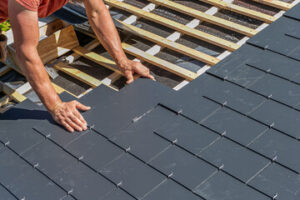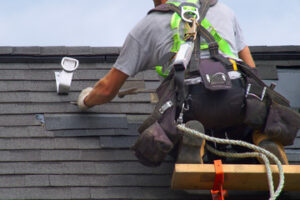When it comes to home improvement, roof repairs are often at the top of homeowners’ priority lists. Roof Repair Murfreesboro TN address issues like water damage, sagging, or leaks and may help prolong the lifespan of a roofing system.

However, delaying the replacement of a roof may ultimately cost more in the long run. So, how do you know when it’s time to upgrade?
When a leak occurs, it can cause water damage throughout the building. This can include stains on ceilings, walls and floors, which can be difficult to repair. It can also lead to odors in the building, as mold thrives in damp environments. Water leaking from a roof can also damage electrical wires. Leaving it unrepaired can create an unsafe environment, especially for employees and clients in the building.
Having a regular roof maintenance program is essential to ensure that leaks do not occur. However, if they do, it is crucial that the proper steps are taken to identify the source of the problem and correct it.
Some common signs of a leaky roof include wet spots on the ceiling and walls, puddles in the attic, discoloration on ceilings, walls or carpeting and the smell of mildew or musty odors. If you notice any of these, it is time to call a professional to check for and address the issue.
Leaks are often caused by poor flashing and can be found around skylights, vents, and other features that protrude through the roof. The flashing is designed to seal around these areas, but if the material is not quality or if it was installed incorrectly, it can fail.
Another area where leaks often occur is along the valleys of a roof, which are the areas where two planes of the roof come together. This is because these areas are vulnerable to moisture because they are between indoor and outdoor air temperatures. If the valleys are not sealed properly, rainwater can seep through these areas and into the building.
A final location where leaks are commonly found is inside ductwork. This is often due to the carelessness of maintenance staff who are not paying attention to the condition of the ductwork, or it can be due to problems with the roof itself.
When you discover a leak, it is important to move items like machines, furniture, wall decor and personal belongings away from the area as much as possible. It is also a good idea to put buckets on the floor under the leaky area to catch any falling water until someone can get to it. If items are too large to move, covering them with tarps can be a quick solution until the leak is fixed.
Sagging
While the occasional bit of sagging isn’t necessarily an emergency, it’s important to address any structural issues as soon as you spot them. Putting off roof repair will lead to the problem snowballing and could result in costly repairs or even a collapsed roof.
Whether you’re dealing with a slight sag or something more noticeable, it is essential to hire an experienced roofing contractor to assess the cause and recommend the most appropriate course of action. This will likely include sistering the rafters or reinforcing the trusses with support brackets to improve their structural integrity. It may also involve replacing any rotted or deteriorated wooden beams, sheathing, or other materials. If water damage is the culprit, it may also be necessary to fix leaks and improve the drainage system.
Sagging can be caused by a variety of factors, including insufficient support or poor construction. However, if the issue isn’t addressed promptly, it can result in major damage to the structure of your home and even endanger the safety of those inside.
The most common cause of roof sagging is moisture damage, which can weaken the wooden beams, joists, and trusses that make up the roof’s structure. When water seeps through shingles, leaks, or blocked drainage systems, it can lead to mold and mildew, which can further compromise the wood’s strength. This is why it’s so important to clear gutters regularly and schedule regular roof maintenance to keep water damage at bay.
As homeowners, it’s easy to overlook signs of sagging in your roof and assume they’re not an immediate concern. However, the truth is that ignoring them will only worsen the problem and lead to costly repairs down the road. By taking the time to identify and implement the right solutions, you can ensure your roof is safe, secure, and in good shape for years to come.
Although modern roofing materials are designed to last for decades, all materials experience natural wear and tear over the years. Even with regular inspections and timely roof repair, most roofs will eventually reach the end of their lifespan. When this happens, sagging can be an indicator of underlying problems with rafters or supports. If left unchecked, a sagging roof can collapse or cause water to seep into the interior of your home, resulting in expensive repairs and potential health risks for those inside.
Dry Shingles
As your roof is constantly exposed to the sun’s heat and UV rays, the asphalt within your shingles naturally wears down over time. This process leaves your shingle less flexible and more vulnerable to damage. Overtime, this can lead to buckling. This is a visible waved distortion that runs vertically up your shingle roof. A buckling shingle will become more susceptible to wind and ice damage, and it can easily tear off.
If you’re not looking for a roof replacement or a new roof, you can try to repair a damaged shingle with some basic supplies. You can find a variety of metal roofing patching materials, including polyurethane and silicone sealants that adhere to wet surfaces and resist yellowing under UV exposure. You can also use a metal patch or butyl tape to repair holes, rust spots, and seams. When patching, choose a day that’s warm and dry for best results.
A drooping or sagging roof is an immediate sign that your roof needs replacement. This is because a drooping roof exposes your home to potential moisture problems and may be a source of mold or fungi. Additionally, it’s more likely to collapse and leave your home vulnerable to further damage.
You might notice that one or two shingles are missing or have cracked. While this isn’t the end of the world, it’s a sign that your shingles are getting old and need to be replaced.
Another way to check for aging is to look for excessive shingle granules in your gutter system or other areas of the house. When shingles are older, they lose their ability to repel water and will have loose granules that fall off. A professional roof repair company can inspect your roof for signs of aging and recommend an appropriate course of action. Keeping your roof in good condition is vital to protecting your home, so regular inspections and maintenance are important.
Age
Your roof is one of your home’s most important components, protecting you and your family from the elements and contributing to the structure’s integrity. However, the roof is subjected to constant wear and tear from weather conditions and aging that can lead to significant problems if not addressed early on. Knowing the condition of your roof helps you determine whether to repair the damage or replace the entire roof.
Repairs are often the better option if the roof is not yet at the end of its expected lifespan and is in good overall condition. However, if you have multiple leaks and widespread water damage, replacing the whole roof with resilient materials is usually the smarter long-term investment.
A new roof can also provide improved energy efficiency and increase the resale value of your home. It is best to schedule regular maintenance and inspections, especially after stressful weather conditions, to identify any issues before they become more severe.
Shingles become brittle as they age, losing their natural oils that enable them to bend and expand with the different climatic conditions. Eventually, these oils dry out and the shingles start to curl, crack, stain or lose their color. The areas of your roof that are most prone to this type of wear and tear are the valleys, which are the points where two slopes meet. If you notice any dipping or damaged areas in the valleys, a professional can usually reinforce these areas with minimal cost. However, widespread shingle damage or extensive rot could mean the roof is nearing the end of its lifespan.

